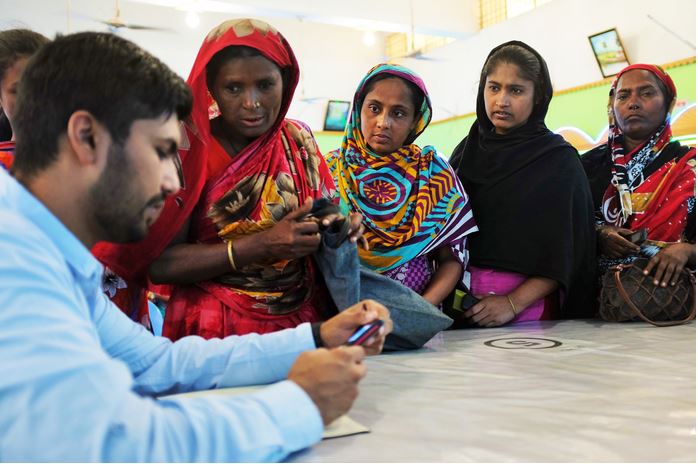Heidi Berg and her team was one of the winners of the first round of Ignite intrapreneurship programme. She and Nazmin Neza are now developing Engage, a new business venture, in Grameenphone, Telenor Group’s company in Bangladesh.
The goal with our product is to help over one million sales agents in Telenor to communicate better with their customers.
“We are making a platform for the organisations to easily manage what information reaches the end customers, tailoring the solution for the needs of the retail agents who are the actual touchpoint.”
Where did this idea come from?
“I worked previously in the development sector. I learned a lot about how challenging it was for microfinance institutions and NGOs to reach mass markets with correct information in low educated and low connectivity settings,” says Berg.
After joining a Telenor project in Bangladesh, she quickly discovered that retail distribution is just as tricky in mobile financial services and other new products and services offered by mobile operators.
“I was worried about the distance from the spreadsheet models we were making in the office and the results from our market research.”
“It is an easy model that each retailer can sell x products to y customers, but it is not at all easy to execute this in the market. Selling such products includes explaining the concept ‘bank account’ to someone who has only seen cash, and interest rates to someone with very little education.”
“The field force is not a machine, and the individuals have capacity limitations both when it comes to time and ability to remember details.”
After discussing this problem with others, she got the idea for Engage.
Through the Ignite programme, she and her co-founders could work on the project for three months, get training in running a start-up and create a prototype. Their idea showed potential, so Berg is now developing it to become new product within Grameenphone.
You will win the race with Lean Startup
Berg can’t emphasize enough how important the Lean Startup method was in order to develop this idea further.
“We are running the product development as a Lean Startup, in line with the new way of working on product development across Telenor Group. Lean Startup is a great approach to keep you focused as it is almost a scientific way of working.”
How does it work?
“You define very specific hypotheses that you test with real customers almost daily. You gain learning from these before you decide on your next steps. This makes you kill bad ideas very quickly and keep focused on individual bits of your solution at the time.”
“So, if you have an idea, you make something very basic like a paper prototype, and test it with a small number of customers. If you learn that 4 out of 5 customers in your defined segment don’t respond well to it, do you think it helps scaling this idea to 100 customers?”
She mentions the old Aesop fable – The Tortoise and The Hare. The slow-moving tortoise challenges the hare to a race. The hare is over-confident and midway through takes a nap. When the hare awakes, he finds that the tortoise has slowly crawled to the finish line.
“I feel a lot like we are the tortoise going forward with very slow steps. We test one and one feature, doing no coding, no scale, no big budgets. But that is good, because we all know who wins the race!”
“We avoid low customer understanding, scope creep and unnecessary spending.”

How to be a foreign entrepreneur in Bangladesh?
Engage`s customers are retail agents who don’t speak English. Since Lean Startup is all about customer interaction the project is fully dependent on the local resources.
Berg is originally from Norway. She says that there is an upside of being a foreigner when she discusses the product with her team.
“It is easier for me to ask the stupid questions. I can dig a lot into details about how and why things work because no one expects me to know from before. Locals might overlook things they are so used to seeing every day that they don’t think it’s relevant to question.”
“One really needs to spend time in the countries and with the people to understand the implications of the differences.
What are the main culture differences that you experience in Asia?
“Where to start?”, she says smiling.
“Things like the understanding of time: does 10 o’clock mean ten or somewhere around ten. And how you get a message across, how direct you are. People in Bangladesh communicate in quite a different way than Norwegians.”
Can you give an example?
“We Norwegians find emailing very comfortable. However, in Bangladesh the culture is very verbal and you don’t get things done by pushing emails.”
“You have to talk – meet in person or on the phone. You need to invest a lot more in the personal relationships with everyone you work with.”
Her second advice is to be aware of the hierarchies and social status.
“Norway is probably the most egalitarian culture in the world. The Asian countries are very hierarchical.”
Her third advice is to read books about local culture.
“Reading novels from the perspective of local people makes you see things from their side, which can be very powerful. And reading up on culture research helps you put words to it. I strongly recommend the book The Culture Map by professor Erin Meyers for anyone working in multicultural teams.”
This article was originally posted on Planet Telenor.
 Nordic Startup News Early Stage Startup News From The Nordics
Nordic Startup News Early Stage Startup News From The Nordics


